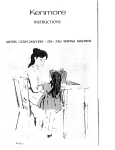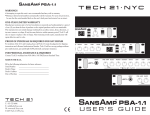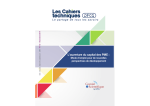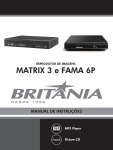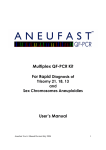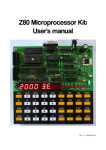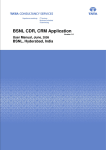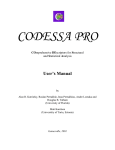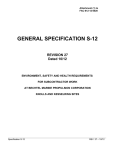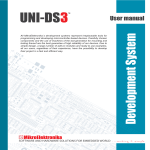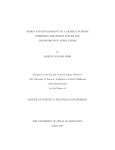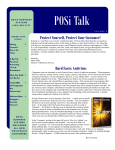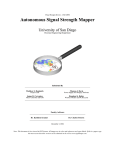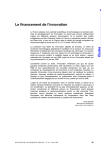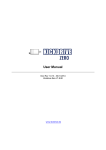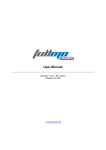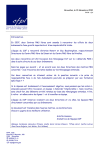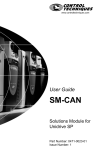Download Draft Proposal - Lane Department of Computer Science and
Transcript
CpE 180 SPRING 2001 CAN BUS DIAGNOSTIC TRANSLATOR PROPOSAL TEAM NUMBER 19 BUDGET TOTAL $179 NAMES OF GROUP MEMBERS KENNETH HECK JOHN MURPHY FACULTY MONITOR PROFESSOR WILS L. COOLEY SPONSORS PROFESSOR ROY S. NUTTER PROFESSOR G. MICHAEL PALMER 04/06/2001 Contact Person: Kenneth A. Heck Route 2 Box 182 Fairmont, WV 26554 (304) 363-6824; (304) 363-2814 [email protected] TABLE OF CONTENTS TABLE OF CONTENTS............................................................................................. 2 SECTION 1. INTRODUCTION .................................................................................. 3 SECTION 2. DESIGN OBJECTIVES ......................................................................... 5 2.1 Design Goals and Constraints...................................................................................................... 5 2.2 Design Specifications.................................................................................................................. 6 2.3 Deliverables................................................................................................................................ 9 2.4 Validation................................................................................................................................... 9 SECTION 3. SYSTEM DESCRIPTION .................................................................... 11 3.1 System Description ................................................................................................................... 11 3.2 Block Diagram.......................................................................................................................... 12 3.3 Data Flow Diagrams ................................................................................................................. 13 SECTION 4. ORGANIZATION AND PLANNING .................................................. 16 4.1 Scheduling................................................................................................................................ 16 4.2 Division of Responsibility ......................................................................................................... 17 SECTION 5. BUDGET.............................................................................................. 18 5.1 Budget ...................................................................................................................................... 18 5.2 Budget Justifications ................................................................................................................ 19 SECTION 6. QUALIFICATIONS ............................................................................. 20 6.1 Kenneth Alan Heck, MS ........................................................................................................... 20 6.2 John Murphy............................................................................................................................. 22 SECTION 7. REFERENCES ..................................................................................... 23 7.1 Standards.................................................................................................................................. 23 7.2 Websites ................................................................................................................................... 23 SECTION 8. APPENDICES...................................................................................... 24 8.1 Reliability Estimate................................................................................................................... 24 8.2 Failure Modes and Effects Analysis........................................................................................... 24 8.3 Supporting Information ............................................................................................................. 24 Team 19: CAN Bus Translator : Proposal : Introduction Page 3 SECTION 1. INTRODUCTION Throughout the 1970's and 80's, the electrical systems in automobiles dramatically increased in complexity and weight with the continuing addition of electrical devices, such as sound systems and on-board computers, and with the increasing use of electrical systems for the control of systems that were previously purely mechanical, such as the brakes. These devices and systems required correspondingly sophisticated control and communications systems, especially as their role in the operation of the car became more central. These developments meant difficulty in the design and maintenance of new automobiles, and often meant that people could no longer repair their own cars. The devices themselves and particularly the wiring connecting them became heavy and complicated, and the opportunities for malfunction increased. In an effort to simplify the design and maintenance of new automobiles, Robert Bosch invented the Controller Area Network (CAN) standard in the late 1980's. The problems he faced included the need for safety, the high noise environment of a running automobile, and the need for flexibility and speed of high-fidelity communication among electrical devices in a car. His solution was a high speed bus (Referred to as the CAN bus), the signals on which traveled on a pair of polarity-switching lines, and which was capable of extremely reliable performance. Adoption of the CAN standard by automobile manufacturers came eventually, but the technology found enthusiastic support in other and varied settings, including the fields of industrial automation and medical equipment. Each field that adopted the CAN standard did so with its own small changes and refinements, to the degree that today some implementations have little in common. Team 19: CAN Bus Translator : Proposal : Introduction Page 4 The Formula Lightning team at West Virginia University is one such user of the CAN standard. Led by Dr. Roy Nutter, the Formula Lightning team has devoted itself to the design of a fully electric race car. His team has found that in order to continue their work, it is necessary to have a device which will permit them access to the CAN bus of their car. Team 19: CAN Bus Translator : Proposal : Design Objectives Page 5 SECTION 2. DESIGN OBJECTIVES 2.1 Design Goals and Constraints In order to race a car, everything about that car needs to be in optimal condition. This requires that all the component parts work together well and fluidly without risk of failure. In order to achieve this goal, all the parts of a car must be extensively tested, and all the systems examined. This can be done in the workshop, but often the best measurements and observations are made in the field -- literally, while racing the car around a track. The Formula Lightning race car uses a CAN bus for the control and operation of its electrical systems. In order to ensure the correct and optimal operation of these electrical systems, a means of accessing the bus must be devised. Access to the bus must be had under both workshop and field conditions in order to be of use. Since the CAN bus carries all the communications and control signals of various devices, it is necessary to be able to read all of those signals in a timely fashion in order to interpret them. The ability to respond to or elicit these signals is also desirable, since many devices require interaction in the form of signals on this bus. A device must be built, therefore, to perform this task of communication and control. It must also perform the task of translation from CAN signal to a standard signal that can be read by a technician with a laptop computer running software written by Andy Pertl. This device must enable the technician to read the signals on the bus, whether all the signals or only a selected set, and to write signals to the bus. While this alone is sufficient for workshop use, the nature of the application requires field testing as described above, and so further constraints are placed on the Team 19: CAN Bus Translator : Proposal : Design Objectives Page 6 operation of the device. Due to the economy of space in the Formula Lightning car, the device must operate without a technician or the technician's computer present when the car is in motion. The device must itself, therefore, be of compact size. Due to the occasionally extreme weather conditions of the track, and the conditions present in the interior of a moving race car, the device must be of exceptional durability in order to be of use for any reasonable length of time. 2.2 Design Specifications *According to the notes, this should "never be written in 'essay' format", but I'm not sure how to do it?* In order to be of use for the Formula Lightning project, the device as described above needs to communicate according to the SAE standard described in J1939. It will thus be able to correctly read a signal from a CAN bus line. The signals it must read and write to the bus may be either or both CAN 2.0A and CAN 2.0B, which are similar packet structures differing mainly in length. In order to communicate to the laptop computer, the device must also communicate using the RS-232 standard, using the protocols as defined by Andy Pertl for his software package. The act of writing a signal to the bus requires that the device read the signal from the laptop, and package it correctly for CAN 2.0A or CAN 2.0B. Once correctly packaged, the device must write the signal to the bus according to the arbitration methods defined in the CAN standard. The signal that the device writes may also be stored in such a way that it can be "played back" onto the bus at a predetermined time, or multiple times after Team 19: CAN Bus Translator : Proposal : Design Objectives Page 7 predetermined intervals. In order to do this, the device must be able to accept and process instructions regarding its own behavior, and be able to distinguish such instructions from signals that must be written to the bus. In order to read from the bus, the device must take a signal in its entirety from the bus line, and after determining whether the signal is wanted by the user of the device, relay it to that user. If the user has connected a laptop computer, then the device must communicate the signal via the RS-232 connection described above. If a laptop computer is not connected, the device must store the signals in such a way that they can be retrieved later. Team 19: CAN Bus Translator : Proposal : Design Objectives Page 8 Input Impedance: CAN-side: ................................................... 120Ω +/- 12Ω Device Power Requirements: Power Sources:............................................ External: 12V,supplied by shielded cable Current Draw:.............................................. <200mA Communications: CAN-side: ................................................... Max 1Mbit/sec PC-side:....................................................... Max 115.2Kbit/sec Communications Protocols: CAN-side .................................................... (1) CAN 1.x (2) CAN 2.0A (3) CAN 2.0B (Read Only) PC-side........................................................ RS-232 Connections: CAN-side .................................................... DB-9 CAN-side connector harness........................ (1) DB-9 to 5-pole (2) DB-9 to 6-pole (3) DB-9 to 9-pole PC-side........................................................ DB-9 PC-side connector harness ........................... (1) DB-9 to DB-9 (2) DB-9 to DB-25 Power .......................................................... 2.1mm barrel Operational Environment: Electrical Isolation....................................... Max 24V applied to outside of case Shock (Force) .............................................. Max 4g Pressure....................................................... Max 60psi Water Resistance ......................................... 1ft submersible (or equivalent) Dimensions (excluding external cabling): Case............................................................. 2.00” H x 5.00” W x 6.00” D (51mm H x 127mm W x 153mm D) Weight......................................................... 3.0 lbs (1.37 kg) PC Requirements: Must run CAN software written by Andy Pertl Team 19: CAN Bus Translator : Proposal : Design Objectives Page 9 2.3 Deliverables The device, when finished, will consist of a box as described above -- no larger than 2"x5"x6", weighing not more than 1.37 kilograms, with four openings. The first opening will allow a cable to connect the device to the CAN bus via DB-9. The second opening will be a DB-9 type socket for a cable connecting to a computer. This second opening will be pluggable to prevent entry of dirt, oil or water. The third opening will allow a power cord. The last opening will permit a flash memory card. This opening will also be sealable. The power cord and CAN bus cable will be provided with the device. The user must provide the cable connecting to the DB-9 socket. One flash memory card will be provided with the system. Additional cards of the same type may be used by the user, but purchase, storage, and care of these cards is solely the responsibility of that user. 2.4 Validation In order to determine that the device works correctly, the following tests will be performed: The delivered device will be connected to a laptop computer and a working CAN bus. This same bus will have on it a similar device (of outside manufacture) for testing purposes. First, the system will be run so that the bus will carry signals from multiple sources. The device being tested will identify all of these signals and relay them. The signals relayed by the delivered device will be compared to those relays by the outside device to ensure that all signals have been received, and no extraneous signals reported. Team 19: CAN Bus Translator : Proposal : Design Objectives Page 10 The delivered device will then be instructed to send certain signals over the bus. The outside device will be consulted to verify that these signals have been sent correctly. The delivered device will be given instructions by the computer to store all signals from a given source on the bus (Identified using a CAN numeric identifier) and then attached to a CAN bus without the computer attached. The system will be run so that the bus carries signals from this source for two minutes, then shut down, and the delivered device attached to a computer to relay the stored data. Lastly, the device will be dropped onto the ground from a height of three feet, sprayed with water, and then subjected to all of the above tests once more. Team 19: CAN Bus Translator : Proposal : System Description Page 11 SECTION 3. SYSTEM DESCRIPTION 3.1 System Description The device will be a single-board electronic device with a 12-volt DC power supply (external). It will contain a 20MHz oscillator as the clock, the DB-9 connectors necessary for interfacting the PC and the CAN bus, and a connector for the flash memory card. The PC's DB-9 connector will be electrically isolated from the rest of the device using opto-isolators. PIC chips will handle the tasks of interfacing with the CAN bus, interfacing with the computer (via RS-232), storing information to the flash memory, receiving and executing instructions from the computer, and both determining then communicating error states. Team 19: CAN Bus Translator : Proposal : System Description Page 12 3.2 Block Diagram Team 19: CAN Bus Translator : Proposal : System Description Page 13 3.3 Data Flow Diagrams CAN Bus CAN Signal CAN Signal Translate CAN to RS-232 Translate RS-232 to CAN RS-232 Signal PC via RS-232 Level 0 DFD RS-232 Signal Team 19: CAN Bus Translator : Proposal : System Description Page 14 CAN Bus CAN Signal CAN Signal Convert signal to TTL TTL to CANReady signal Raw TTL Signal Buffer 1 TTL Signal Raw TTL Signal Package TTL as RS-232 Remove RS-232 and form TTL Packet RS-232 Signal Buffer 2 RS-232 Signal RS-232 Signal Send RS-232 to PC Send RS-232 to CAN RS-232 Signal RS-232 Signal PC via RS232 Level 1 DFD Team 19: CAN Bus Translator : Proposal : System Description Page 15 Raw TTL Signal Buffer 1 Raw TTL Signal Error-check signal Error Signal Valid Signal Generate status and error signal Generate data packet Partial RS-232 Error Packet Partial RS-232 Data Packet Package RS-232 packet with proper parity Complete RS-232 Packet With Parity Buffer 2 Complete RS-232 Packet With Parity Level 2 DFD Team 19: CAN Bus Translator : Proposal : Organization and Planning Page 16 SECTION 4. ORGANIZATION AND PLANNING 4.1 Scheduling (OK, this is just a list of things we'll need to do) buy parts build case lay out and build circuit program PICs learn how to use flash memory cards learn how to use Pertl's program (And make any changes needed to access our additional functionality) write instruction calls write user manual test parts should be bought soon, and all the "learn" stuff, too. How are we going to deal with the summer in all this? Do we include it in our plans, or just pretend we're not doing anything over the summer? 1 20 20 20 10 20 10 0 5 0 5 10 3 5 119 2) Learn to use and wire CANBus PIC 7) Program the CANBus PIC 3) Learn to use and wire PIC#2 8) Program PIC#2 6) Learn to use and wire memory card 4) Learn to use Andy Pertl’s software 5) Make changes to AP software 9) Design power supply 10) Learn to use and wire the serial port 11) Learn to etch boards 12) Learn to build/etch prototype board 13) Build case to meet specifications 14) Test project to ensure specifications TOTAL KAH 119 5 3 10 5 5 0 40 10 10 0 5 0 5 1 JM Effort 1) Buy Parts Task 08/ 20 08/ 27 09/ 03 09/ 10 09/ 17 09/ 24 10/ 01 10/ 08 10/ 15 Week Beginning 10/ 22 10/ 29 11/ 05 11/ 12 11/ 19 11/ 26 Team 19: CAN Bus Translator : Proposal : Organization and Planning Page 17 4.2 Division of Responsibility Team 19: CAN Bus Translator : Proposal : Budget Page 18 SECTION 5. BUDGET 5.1 Budget Project Cost Proposal Cost 1. CANBUS PIC – MCP2510 $7 $7 2. Additional PIC for other Functions $10 $10 3. PICStart Plus Programmer $150 $0 4. MAX232A $5 $0 5. DB9 connector (Receptacle) $3 $3 6. DB9 connector (Plug) $3 $3 7. Circuit Board Etch Kit $30 $30 8. Capacitors, Resistors, Inductors $5 $5 9. Case (Aluminum) $15 $15 10. Power Connector (Receptacle) $1 $1 11. Power Connector (Plug) $4 $4 12. Oscillator $3 $3 13. IC Sockets $1 $1 14. Compact Flash Memory (32MB) $45 $45 15. Compact Flash Socket $5 $5 16. DC-DC Converter $9 $9 17. Fuse Holder $1 $1 18. Power Switch $2 $2 19. Any other discrete components $5 $5 20. Miscellaneous (solder, etc.) $5 $5 21. Shipping/Handling Charges $20 $20 TOTAL $334 $179 Requested from Sponsors=$79 Requested from CSEE Department=$100 ____________________________ Sponsor Signature Date ____________________________ Chair Signature Date ____________________________ Monitor Signature Date Team 19: CAN Bus Translator : Proposal : Budget Page 19 5.2 Budget Justifications 1. CANBUS PIC – MCP2510 Digi-Key 2. Additional PIC for other Functions Digi-Key 3. PICStart Plus Programmer Digi-Key 4. MAX232A Digi-Key 5. DB9 connector (Receptacle) Newark 6. DB9 connector (Plug) Newark 7. Circuit Board Etch Kit Newark 8. Case (Aluminum) Newark 9. Newark Power Connector (Receptacle) 10. Power Connector (Plug) Newark 11. Oscillator Newark 12. Compact Flash Memory (32MB) Buy.com 13. Compact Flash Socket Newark 14. DC-DC Converter Newark 15. Fuse Holder Newark 16. Power Switch Newark Team 19: CAN Bus Translator : Proposal : Qualifications Page 20 SECTION 6. QUALIFICATIONS 6.1 Kenneth Alan Heck, MS Kenneth Alan Heck, MS Route 2 Box 182 Fairmont, WV 26554 Home Phone : (304) 363-6824 E-Mail: [email protected] Education : 01/98-Present: University : Coursework : West Virginia University, Morgantown, WV Pursuing BS in Computer and Electrical Engineering 08/96-12/96 : College : Registration : License : Santa Fe Community College, Gainesville, FL : EMT - B, December 1996 National Registry of Emergency Medical Technicians - #B1103946 West Virginia - #B-036323 08/92-02/96 : University : Thesis : Research Director : Graduate Coursework : Equipment Skills : Other Duties : 08/88-05/92 : University : Coursework : Special Topics Course : Equipment Skills : Honors/Scholarships : University of Florida, Gainesville, FL : MS, December 1995 "General Synthetic Methods for Alpha-hydroxy Ketones" Dr. Alan R. Katritzky, Kenan Professor, Center for Heterocyclic Compounds 1 sem. each : General Organic, Organic Synthesis, Organic Mechanism, Organic Spectroscopy, Inorganic, Organometallics, Quantum Theory 300MHz NMR's : Varian Gemini-300, VXR 300, GE QE-300; HPLC Katritzky group lab steward, miscellaneous equipment repair West Virginia University, Morgantown, WV : BA, Chemistry December 1992 Mostly BS and Honors courses, organic courses with microscale techniques X-Ray diffraction IR : Perkin-Elmer; PC-based systems (i) WVU Presidential Scholarship (ii) John A. Moore (Chemistry) Scholarship (iii) WVU Honors Program Experience : 01/00-Present : Business : Title : Functions: 08/97-12/99 : Employer : Title : Supervisor : Duties : Heck Solutions Owner Software Development specializing in Access 97 Custom-built PC’s/Upgrades PC Diagnosis/Repair West Virginia University, Financial Aid Office, Morgantown, WV 26506-6004 Information Systems Technician Tresa Weimer, Supervisor : (304) 293-8571 ; 1-800-344-WVUl System Administrator of Local Area Network running Novell Netware 4.11 Training employees to use software : Netware 4.11, Win 95, Win 98, WP6.1, FoxPro 2.6, BANNER 2.15, MS Office Pro 97 Maintenance and Repair: Various PC’s and Printers Developing need-specific software for varying uses in the office : Access 97 , FoxPro 2.6 Supervision of Work Study employees Team 19: CAN Bus Translator : Proposal : Qualifications Page 21 06/97-Present : Employer : Title : Supervisor : Duties : 06/96-02/97 : Employer : Title : Supervisor : Duties : 01/93-02/96 : Employer : Title : Supervisor : Duties : 08/88-07/92 : Employer : Title : Supervisor : Duties : 03/91-07/92 : Employer : Title : Supervisor : Duties : Monongalia General Hospital, 1200 JD Anderson Drive, Morgantown, WV 26505 Part-Time Monitor Tech Glenda Broad: (304) 598-1506 Watching 5 monitors capable of 8 strips each, paging nurses for dysrhythmias Recording and analyzing rhythm strips once per shift Tracking patient room assignments, notifying necessary personnel for admits/discharges Maintaining patient information board for physicians, nurses, administrative personnel Farchan Laboratories, 4906 NW 53rd Street, Gainesville, FL 32653 Bench Chemist - Research and Development Dr. Radi Awartani : (352) 374-6825 Running small (50mL) to large (22L) scale reactions as directed Supervising technicians in running reactions Quality control analysis by GC, HPLC, IR, Karl-Fischer water analysis, titration, melting point and refractive index Lab equipment maintenance University of Florida, Department of Chemistry, Gainesville, FL 32611 Graduate Research/Teaching Assistant Prof. Merle A. Battiste : (352) 392-0552 3 sem. General Chemistry, 2 sem. Organic Chemistry Lab West Virginia University, Financial Aid Office, Morgantown, WV 26506-6004 Clerical Assistant Brenda Thompson, Director : (304) 293-5242 ; 1-800-344-WVUl Clerical work : Filing, typing, answering phones, stocking, errands Developing need-specific software for varying uses in the office : FoxPro 2.0 LAN Training employees to use software : Netware 2.10, WP5.1, FoxPro 2.0, DOS PC Maintenance First National Bank of Morgantown, 201 High Street, Morgantown, WV 26505 (now Huntington Banks, WV) Part-Time Computer Operator Scot Epling, Assistant Vice President : (304) 367-2452 ; 1-800-377-BANK Unsupervised after hours final sorting of personal checks using a Honeywell DPS 6 Developing need-specific software : dBase IV 1.1 and QuickBasic Software installation : WP5.1, Lotus, PCTools Diagnosing and correcting PC hardware problems Publication : A. R. Katritzky, K. A. Heck, J. Li, A. Wells, C. Garot, "1-(1-Alkenyl)benzotriazoles: Novel Equivalents for the Synthesis of α-Hydroxy Ketones", Synth. Commun., 26(14), 2657-2670. (1996) Team 19: CAN Bus Translator : Proposal : Qualifications Page 22 6.2 John Murphy John Murphy 910 Montrose Ave Morgantown, WV 26505 (304)292-8870 [email protected] Resume Objectives: To obtain a graduate degree in electrical engineering in the particular field of robotics. To gain experience designing, building, controlling, and maintaining robotic systems. Job Experience: Intern, NASA IV&V Summer, 1996 Fairmont, WV (Funded by George Washington University) Involved with SORT (Software Optimization and Reuse Technology) project, a software engineering effort as related in particular to Marshall Space Flight Center's flight furnace project. Oral demonstrations of progress given both to peers and superiors at the end of the internship Math tutor, West Virgina University Math Department Morgantown, WV Aug 2000 - present Education: West Virginia University 1997-present Morgantown, WV (Expected graduation date: Dec 2001) Degrees to be received: BSCpE, BSEE, emphasis in control systems Kansai Gaikokugo Daigaku (Kansai Foreign Language University) Fall 1999 Hirakata-Shi, Osaka, Japan Morgantown High School Morgantown, WV 1994-1997 Skills: Programming (Windows, MS-DOS and UNIX environments): C, Java, Intel x86 assembly, PIC assembly, PIC C, Ada, Matlab, Perl, Lisp Spoken and Written Japanese Use of fuzzy logic and genetic algorithm techniques, particularly in control applications Experience designing with and programming for PIC chips Team 19: CAN Bus Translator : Proposal : References Page 23 SECTION 7. REFERENCES 7.1 Standards 1) SAE J1939 7.2 Publications 1) Design with PIC Microcontrollers, Peatman, John B., Prentice Hall, New Jersey, 1998. 7.3 Websites 1) AnyBus Official Site : http://www.hms.se/ 2) CAN in Automation : http://www.can-cia.de/ 3) Dearborn Group, Inc. : http://www.dgtech.com/products/dpa.phtml 4) DeviceNet-ODVA Official Website : http://www.odva.org/10_2/00_fp_home.htm 5) International Organization for Standardization homepage : http://www.iso.ch/ 6) KVASER Controller Area Network pages : http://www.kvaser.com/can/index.htm 7) OSEK/VDX : http://www.osek-vdx.org/ 8) Triangle Data : http://www.triangledigital.com/products/productscanbus.htm 9) Wesley Tang's Can Links : http://www.warwick.ac.uk/~esrpy/links.htm 10) Zanthic Products : http://www.zanthic.com/can4usbm.htm Team 19: CAN Bus Translator : Proposal : Appendices Page 24 SECTION 8. APPENDICES 8.1 Reliability Estimate 8.2 Failure Modes and Effects Analysis 8.3 Supporting Information

























